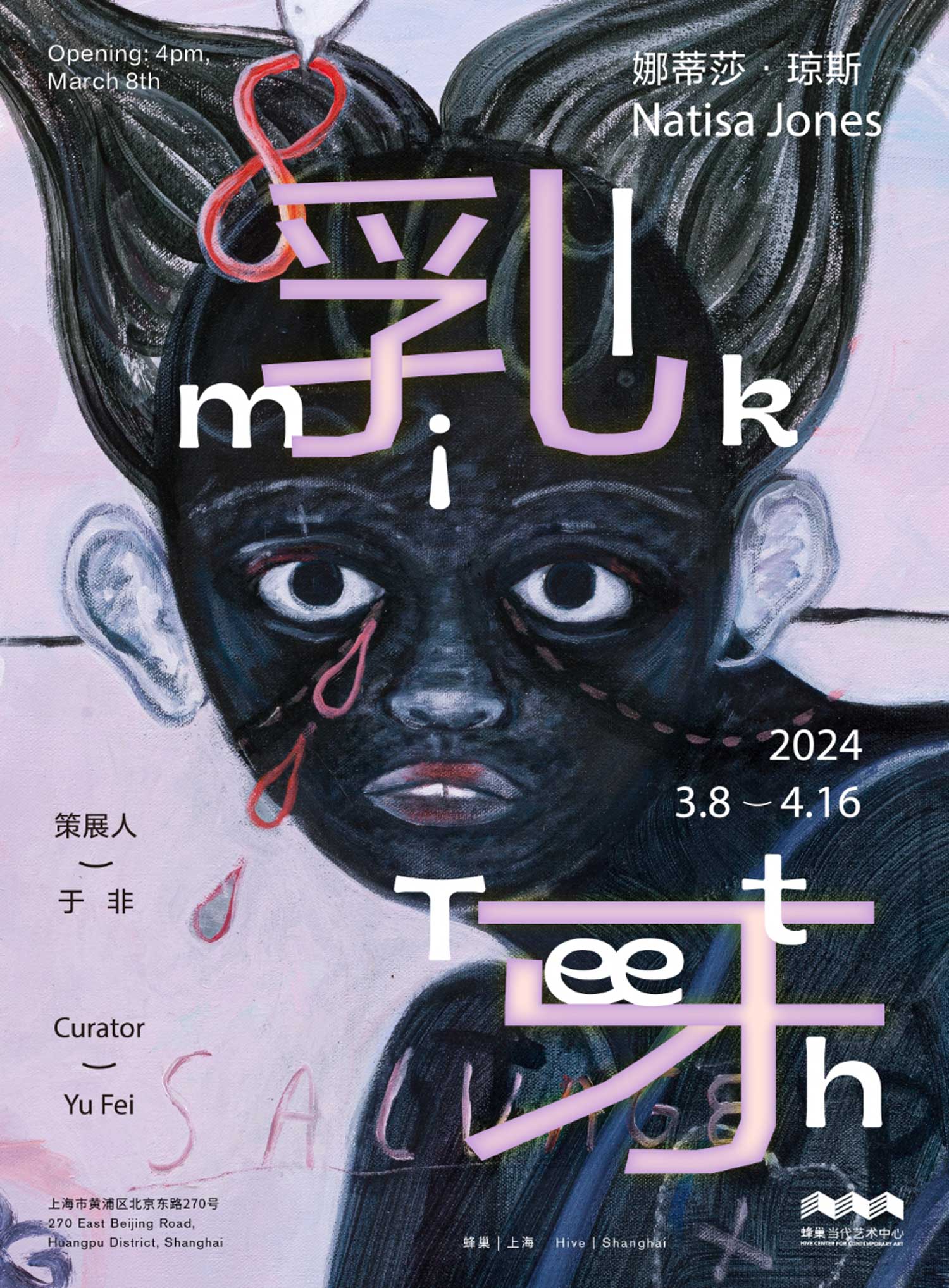展期 Period:
2024.3.8—2024.4.16
艺术家 Artist:
策展人 Curator:
地点 Venue:
蜂巢当代艺术中心 Hive Center for Contemporary Art(上海)
新闻稿 Press Release:
蜂巢当代艺术中心荣幸宣布,将于2024年3月8日在蜂巢|上海空间推出印尼艺术家娜蒂莎·琼斯个展“乳牙”,集中呈现她最新的绘画创作。此次展览是娜蒂莎·琼斯继2022年蜂巢北京个展“直到成为一座火山”之后在中国的第二次个展。展览由蜂巢当代艺术中心策展人于非策划,将持续至2024年4月16日。
人的乳牙有着不算太长也不算太短的生命。平均从出生六个月开始萌发第一颗,到大约十二岁全部脱落。童年的落幕与青春期的悄然而至就这样由乳牙隐秘地标记。娜蒂莎·琼斯将“乳牙”视作生命中各个阶段注定失去与告别的象征之物,投射着复杂难言的心绪:既有对遗失天真的感伤,亦有对投入全新生命周期的喜悦;既有对割舍阴翳过往的释怀,亦有对面临未知成长的焦灼。而这些无法被天平轻易衡量的得与失,爱与痛,均是她一直以来的绘画创作从未驶离的命题。在最近一年的时间中,娜蒂莎折返于阿姆斯特丹的工作室与巴厘岛的童年家中进行两地创作,在这个伴随着追忆思绪与内观觉知的拉锯过程里,连绵不断的心理肖像次第显形。
“过渡性现象”是英国精神分析学家唐纳德·温尼科特研究关于婴儿认识世界并建立自我边界时所提出的概念。婴儿借助“过渡性对象”——某个熟悉的玩具亦或其他任何为其所“占有”的,用于排遣焦虑的物件——潜入“过渡性空间”,即介于内心世界与外部世界之间的体验空间。在这个幻想与现实交织重叠的神秘区域,创造力由此萌生。有趣的是,这一现象并不单单停留于人的幼年期,甚至人终其一生都在与它发生关联。从某种意义上来说,绘画之于娜蒂莎而言正是独属于她的过渡性空间,是她得以操纵与她发生直接情感关联的意象来建立与包括自身在内的世间万物真正连接的安身之所。
娜蒂莎不曾追求画面的精致、平滑与完整。相反,它们往往显得粗粝、生涩而稚拙,充盈着无法忽视的情感浓度,通过多重视觉元素的奇妙勾连与组合汹涌释放。反复出现、不断变体的意象与符号共同塑造了娜蒂莎的绘画生命体,与她同频地经历着生长与新陈代谢。每一幅画面的元素构成并非是被理性化地组织与设计,而总是在绘画的潜意识行动中确立了存在。从混沌的抽象笔触发端,由色块的大面积铺陈开始,以当下最为真实的身体感知为诱饵,耐心等待着形象的捕获。具象的确立如同磁体,进一步召唤着更多纷繁符号的现身,直至这一由绘画构筑的介于“我”与“非我“的中间地带足够丰饶,足以自洽。
The Hive Center for Contemporary Art is pleased to announce "Milk Teeth", a solo exhibition by Indonesian artist Natisa Jones, focusing on her most recent paintings, to be held on March 8, 2024 at the Hive|Shanghai space. The exhibition is Natisa Jones' second solo exhibition in China, following her solo exhibition "To Become a Volcano" at Hive|Beijing in 2022. The exhibition is curated by Yu Fei, curator of the Hive Center for Contemporary Art, and will run until April 16th, 2024.
Human milk teeth have a life neither too long nor too short. On average, they first erupt six months after birth, and shed at about twelve years of age. The end of childhood and the quiet arrival of puberty is thus subtly marked by milk teeth. Natisa Jones approaches “milk teeth” as a symbol of destined losses and farewell at different stages throughout life, projecting complex and inexplicable emotions: the grief of lost innocence and the joy of entering into a new stage of life; the relief of parting with a gloomy past and the anxiety of confronting the uncertainty of growth. These gains and losses, love and pain, unable to be measured by scales, are the subjects from which she has never departed in her paintings. In the last year, Natisa has been working between her studio in Amsterdam and her childhood home in Bali. In this jostling process, followed by reminiscent thoughts and introspective awareness, a continuous flow of her psychological portraits is revealed in succession.
The concept of ‘transitional phenomena’ was proposed by English psychoanalyst Donald Winnicott in his research on infants’ understanding of the world and establishing boundaries of the self. Through ‘transitional objects’ - a familiar toy or any other object “possessed” by the infant to relieve anxiety - the infant enters the ‘transitional space’, an experiential dimension between the inner and the outer reality. Creativity is thus developed in this mysterious world where fantasy and reality intertwine and coincide. Interestingly, this phenomenon does not stop at early childhood but continues to be associated with humans throughout the span of their lives. In a sense, painting is, for Natisa, a transitional space that exclusively belongs to her, a place where she is able to manipulate imageries with which she is directly and emotionally related in order to form a real connection with all beings in the world, including herself.
Natisa has never sought after delicacy, smoothness, and completeness in her works. On the contrary, they often appear unpolished, raw, and childlike, brimming with an overwhelming sense of emotional intensity, which is released through the marvellous connection and composition of manifold visual elements. The recurring and ever-changing imageries and symbols collectively sculpt Natisa’s form of life in painting, simultaneously experiencing growth and metabolism with her. The composition of the elements in each painting is not rationally organised and structured, yet always assumes its existence in the subconscious action of painting. Starting from the chaotic abstract brushstrokes, spreading out large areas of colour blocks, and bating with the most realistic physical perception of the moment, the artist patiently waits for the figure to be captured. Like a magnet, the establishment of the protagonist further evokes the presence of more diverse symbols until this middle ground between “me” and “not-me” constructed by painting is sufficiently ample to be self-consistent.

